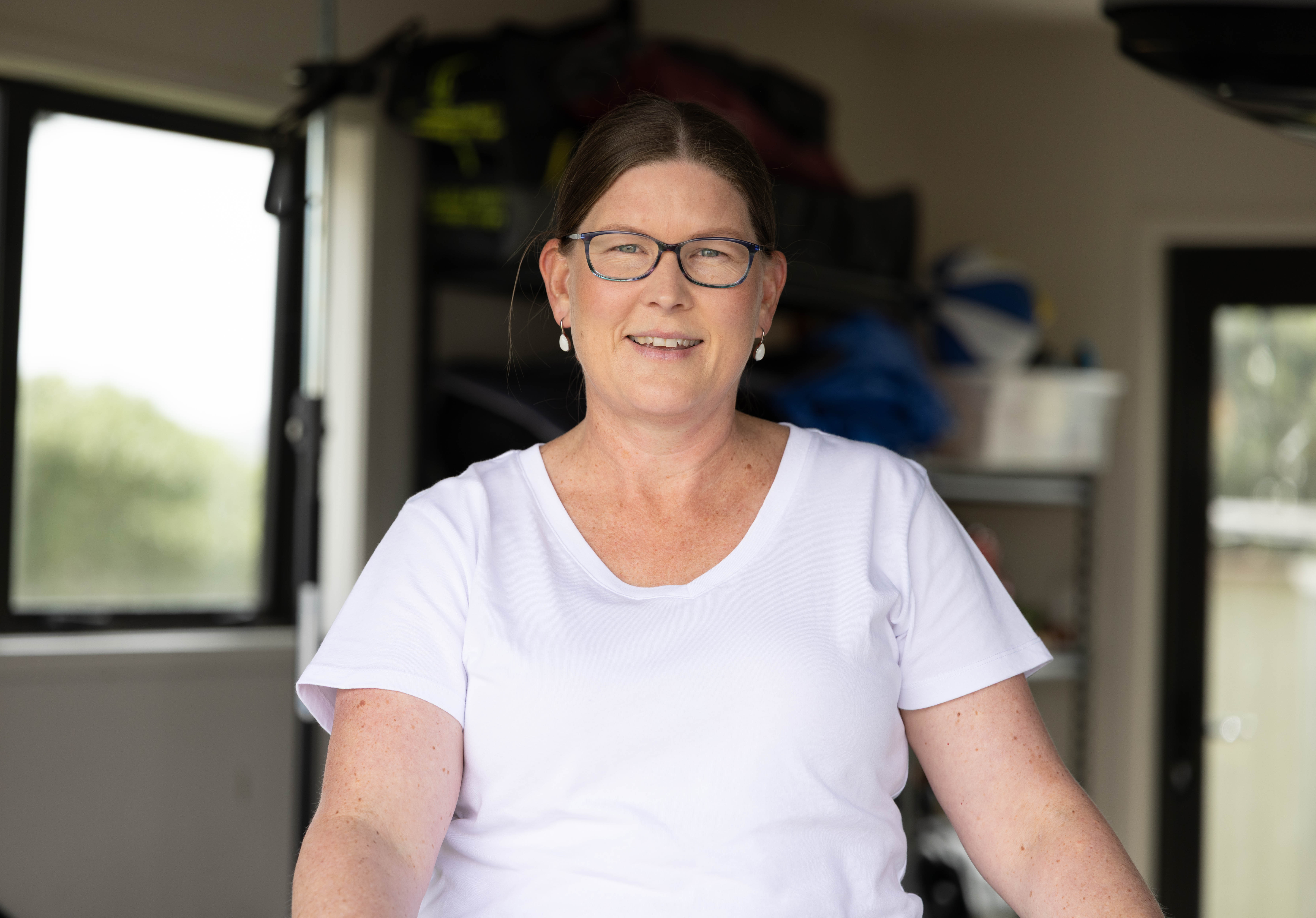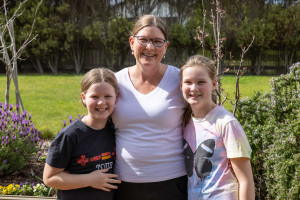Need advice?
This information is general guidance and doesn’t replace advice from your healthcare provider. If you're unsure what type of activity is right for your injury, talk to your physio, doctor, or another healthcare professional.
 ACC Homepage
About us
Mō mātou
Preventing injury
Te kaupare wharanga
Resources
Ngā rauemi
Contact us
Whakapā mai
ACC Homepage
About us
Mō mātou
Preventing injury
Te kaupare wharanga
Resources
Ngā rauemi
Contact us
Whakapā mai
We have reduced hours over the holiday period and are closed on public holidays. Your payments from us may be paid early. See more details.
Intensive care charge nurse Tania Mitchell faced a lengthy recovery from a badly sprained ankle. But by being proactive with her rehabilitation and following the advice of her physio, she was able to keep doing the things she loves.

Visual
Tania standing in her garage talking to the camera while holding the handlebars of her bicycle.
Transcript
I was on a school trip with my daughter and we were down the waterfront doing a scavenger hunt and I wasn't watching where I was walking, and I missed a step and rolled my ankle.
Visual
A still on screen that shows Tania with her foot elevated under a cushion while lying on the couch. Crutches can be seen sitting next to the couch. The visual then shows a close-up photo of her strapped ankle that is bruised and swollen.
Transcript
I knew straight away that it was gonna be quite bad. It was quite sore and quite swollen quite quickly. So I went to the physio the next day to get advice on what I should be doing with the right amount of walking versus rest.
Visual
Tania riding her bike towards the camera on a path outside. We then see footage of Tania with her two school-aged daughters, all three are riding bikes along a gravel path surrounded by small trees and bushes.
Transcript
Initially, I was quite concerned because the physio said it might take three to six months to come right.
Visual
Tania talking to the camera sitting on the couch in her home.
Transcript
So that made me very proactive with the exercises and doing what I was advised to do so I could get it healed and I could get back doing the things that I enjoy quicker.
Visual
We see footage of Tania standing at her kitchen island bench and talking to her two daughters who are eating cheese and crackers.
Transcript
I've got two daughters. I enjoy being out doing activities and spending time with them. So I thought it was really important to get it healed up as soon and as quickly as I could to get back doing the things that I enjoy.
Visual
We see more footage of Tania and her two daughters riding their bikes along a gravel path surrounded by small trees and bushes, and standing with their bikes in a small car park.
Transcript
What I found really useful was the advice about how much activity I should be doing. Rather than just complete rest, that actually weight bearing and continuing to move and weight bear was an important part of the recovery and I could feel in myself that when I kept mobile, it actually felt a bit better, but sitting down all the time, it would actually get stiff and was more painful.
Visual
Tania and her daughters in the garage putting on their helmets and getting their bikes ready for a ride.
Transcript
We do ride bikes and I actually found that that was really good because I wasn't having to put the weight through my ankle the same in the recovery phase.
Visual
We see more footage of Tania and her two daughters riding their bikes before a panning shot of all three standing on the top of a hill with their bikes.
Transcript
So riding the bike was actually, yeah, it was actually a bit easier to keep active. And also with the school holidays, you wanna keep going and get the kids outside and doing things. I didn't want to be stuck inside, you know, laid up with my foot up. So I wanted to be, I was looking for different things that I could do that I could still do with my sore foot, but keep active and keep being outdoors and doing things with the kids.
Visual
Tania sitting on the couch talking to the camera.
When Tania Mitchell was told by her physio that it could take three to six months to recover from her sprained ankle, concern crept through her mind.
It was just before the school holidays and the last place she wanted to be was lying on the couch. The mother of two young daughters loves getting out to do fun activities with them, like bush walking and riding bikes near their home on the hills of Porirua.
She also has a physically demanding job as a charge nurse in the intensive care unit at Wellington Hospital, needing to be on her feet for long periods in gruelling 12-hour shifts.
“I was really worried when the physio told me it could take so long to recover fully,” she says.
Tania’s ordeal began on a school field trip with one of her daughters, when she missed a step and ended up with a badly sprained ankle.
“It was sore and swollen straight away, so I knew it was going to be quite bad.”
Tania was adamant she didn’t want to spend weeks off her feet, so she proactively went to the physio the next morning. She was keen to follow their guidance saying “they are the experts”.
“What I found really useful was the advice about how much activity I should be doing,” she says.
“Rather than just complete rest, they said weight bearing and continuing to move was an important part of the recovery... I could feel in myself that when I kept mobile it felt a bit better, but if I was sitting down it would get stiff and was more painful."
“The physio gave me a clear plan of what I needed to be doing. I knew she was the expert so I thought it was important to follow her advice – I didn’t want the injury to hold me back any longer than it needed to.”
Tania’s main motivation to get back to her best was her daughters, Zoe and Olivia, aged 10 and 12.

Tania and her two daughters, Zoe (left) and Olivia (right)
“Kids keep you quite busy and active, often it ends up being sport and other after-school activities. I enjoy participating in those so I wanted to get back to doing that as soon as possible,” she says.
Some of the activities Tania enjoys doing with her children helped in her recovery.
“We like riding our bikes together and I found that was really good because I wasn’t having to put the weight through my ankle in the recovery phase. So riding a bike was actually a bit easier to keep active,” she says.
“And with the school holidays I wanted to keep going and get the kids outside doing things. I didn’t want to be stuck inside laid up with my foot up, so I was looking for different things I could still do with my sore foot with the kids.”
To stay socially connected during her recovery, Tania also found it beneficial to tweak some of her regular routines, rather than not doing them at all.
“I like to keep connected with people and I found I could just adapt what our plans were based on my ankle,” she says.
“For instance, I’ve got a friend I often catch up with and her children are the same age. Normally, we’d go for a bush walk or do something active but I wasn’t going to be able to do that so we went to the pool instead. That meant I could sit and chat with my friend and the kids could be in the pool playing.
On the work front, Tania was initially concerned about how she would manage her busy shifts in the high-pressure hospital environment. But she talked to her employer about a recovery at work plan and was able to keep off her feet by doing alternative duties in the early part of her rehabilitation.
“I couldn’t stand for long but part of my role is also doing staff management and quality improvement, which is more admin-based,” she explains.
“So I focused more on that and did some of it from home in the first few days. And I was then able to go in and continue working my non-clinical shifts on crutches.
“It was great to still be part of the team and go into work, it made a big difference to my wellbeing.”
When trying to recover from a sprain or strain, research shows rest isn’t always best. Gentle movement can be beneficial and help in your recovery, as Tania found out.
Staying connected to members of your community, whānau and friends can also help you recover, while engaging in a recovery at work plan keeps you connected with your team and provides a sense of purpose.
By staying active, socially connected and doing alternative duties at work, as well as following medical rehabilitation advice, you can recover more quickly and get back to what matters, sooner.